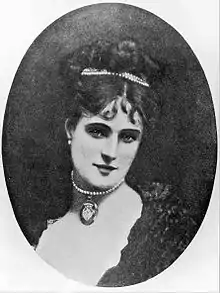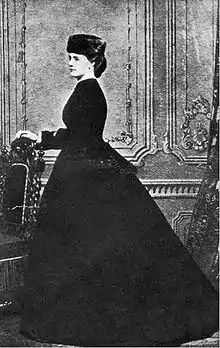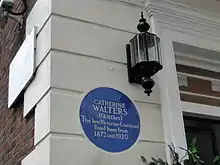Catherine Walters
Catherine Walters, also known as "Skittles" (13 June 1839 – 5 August 1920), was a fashion trendsetter and one of the last of the great courtesans of Victorian London. Walters' benefactors are rumoured to have included intellectuals, leaders of political parties, aristocrats and a member of the British Royal Family.[1]
Catherine Walters | |
|---|---|
 Portrait of Catherine Walters | |
| Born | June 13, 1839 |
| Died | August 5, 1920 (aged 81) |
| Resting place | Franciscan Monastery Crawley, West Sussex, England 51.1133°N 0.1878°W |
| Nationality | English |
| Other names | Skittles |
| Occupation | Courtesan |



Life
Catherine Walters was born on 13 June 1839, the third of five children at 1 Henderson Street, Toxteth, Liverpool, grew up in the Liverpool area[2] and moved to London before her twentieth birthday. Her father was Edward Walters, a customs official, who died in 1864. Her mother was Mary Ann Fowler.
Her nickname is thought to have originated from her working at a bowling alley in Chesterfield Street near Park Lane. (Skittles is the game which evolved into bowling.) At other times she was known as "Mrs Behrens" and "Mrs Baillie", even though she is not thought to have married.
Her classical beauty was matched by her skill as a horsewoman, for which she was almost equally renowned.[3] In the 1860s the fascinating sight of Catherine riding on Rotten Row in Hyde Park drew huge crowds of sightseers. Aristocratic ladies copied the cut of her perfectly fitting "Princess" riding habit, and she was well known as a trendsetter.[4][5]
A letter written to The Times in July 1862 described in detail the fever of anticipation among the waiting admirers of a thinly disguised Catherine:
"Expectation is raised to its highest pitch: a handsome woman drives rapidly by in a carriage drawn by thoroughbred ponies of surpassing shape and action; the driver is attired in the pork pie hat and the Poole paletot introduced by Anonyma; but alas!, she caused no effect at all, for she is not Anonyma; she is only the Duchess of A–, the Marchioness of B–, the Countess of C–, or some other of Anonyma's many imitators. The crowd, disappointed, reseat themselves, and wait. Another pony carriage succeeds – and another – with the same depressing result. At last their patience is rewarded. Anonyma and her ponies appear, and they are satisfied. She threads her way dexterously, with an unconscious air, through the throng, commented upon by the hundreds who admire and the hundreds who envy her. She pulls up her ponies to speak to an acquaintance, and her carriage is instantly surrounded by a multitude; she turns and drives back again towards Apsley House, and then away into the unknown world, nobody knows whither".[6]
She counted among her lovers Aubrey de Vere Beauclerk, with whom she eloped for some months to America in the second half of 1862;[7][8] Spencer Cavendish, Marquess of Hartington (later the eighth Duke of Devonshire), whom she pursued to New York during the American Civil War; Napoléon III; French finance minister Achille Fould;[9] and the Prince of Wales (later King Edward VII). She was also the first love of the poet Wilfrid Scawen Blunt, who remained infatuated with her for the rest of his life.

During her life as a courtesan, her discretion and loyalty to her benefactors became the focal point of her career. There were many rumours about her being involved with certain wealthy men of the time, but she never confirmed or denied these rumours. This gave her great weight in the courtesan lifestyle, and made her a sought-after companion. It also gave long life to her career, and helped her to retire a wealthy woman of society around 1890. Her estate was worth a very considerable £2,764 19s. 6d at her death.[10] As well as her home in Mayfair, which according to DNB she had from 1872, she seems to have had other addresses, judging from a court case in which she was sued for non-payment of a tailoring bill. The other addresses may have been properties she owned. Two were hotels, one in France.[11]
Catherine Walters died of a cerebral haemorrhage on 5 August 1920 at her home at 15 South Street, Mayfair, and was buried in the graveyard of the Franciscan Monastery in Crawley, West Sussex. [12]
Cultural references
In 1864 a London publisher, George Vickers, brought out three fictionalised biographies: Anonyma: or, Fair but Frail; Skittles: the Biography of a Fascinating Woman; and Skittles in Paris. The author was possibly William Stephens Hayward, or Bracebridge Hemyng. The open sale (and commercial success) of the biographies caused expressions of moral concern in contemporary newspapers and magazines.[13]
In 1861, Alfred Austin, a future Poet Laureate, referred to 'Skittles' by name in The Season: a Satire, his poem satirising mid-Victorian social mores. He described her dramatic appearance in Rotten Row, and the covert and jealous interest society ladies felt for her. He also suggested that Skittles and other celebrity prostitutes were attractive not merely because they offered sex, but because they were more natural, less repressed and less boring than the well-bred girls who came to London for the marriage 'season'.[14]
Wilfrid Scawen Blunt's poetic sequence The Love Sonnets of Proteus and his later work Esther are thought to be based on his early affair and later friendship with Walters.[15]
The painter Edwin Henry Landseer submitted a picture called The Shrew Tamed[16] for the Royal Academy exhibition of 1861. It showed a beautiful girl in riding habit reclining against the neck of a horse which is on its knees among the straw. It was ostensibly not a portrait of Walters, but the alleged model, the noted horsewoman Annie Gilbert, resembles her, and the juxtaposition of horse, beautiful woman and prevailing mood of languor troubled contemporary critics;[17] some clearly assumed Walters herself had been the subject.[18] The picture gained the alternative title of The Pretty Horsebreaker.
References
- Albert Edward, Prince of Wales, afterwards King Edward VII: Theo Aronson, 'Walters, Catherine (1839–1920)', Oxford Dictionary of National Biography, Oxford University Press, 2004
- 1851 British Census shows her resident at 123 Queens Buildings, Tranmere, Cheshire, with father and siblings: aged 11, she is a 'scholar'(i.e. schoolgirl)
- Burton, Sarah (6 September 2003). "Review: Courtesans and the Courtesan's Revenge". The Guardian. Guardian Media Group. Retrieved 28 February 2010.
- 'Who rides the best horse in the row? Who drives the most ramapagious ponies? Whom do all the best girls ape in dress and deportment, and in equipage if they can; aye, and in talk, too? Who first set the fashion of the "pork pie" hat?...Why, one of our "pretty horsebreakers".' The Times(London, England), Saturday, 29 June 1861, p. 12
- AUSTIN, Alfred, The Season: a Satire (1861):"..to their Sisters of the Season, Skittles is as well-known, and as much an object of interest, as the last shape of Madame Elise; and the skill with which, in talk à deux, they manoeuvre the conversation into speculations upon her origin, abode, and doings, fully supports their reputation for tact."
- The Times, 3 July 1862, pg. 12
- 'Mr and Mrs Beauclerk got on very well together until July 1862, when they went to Ems. A Miss Walters, who was better known as "Skittles,” happened to be staying there at the time, and Mr Beauclerk became smitten with her... Having travelled about with Miss Walters for some months the respondent, in 1863, returned to this country by himself..': The Times, Saturday, 1 November 1890; pg. 4; Issue 33158; col E
- '...the respondent made the acquaintance of a Miss Walters, better known as "Skittles," with whom he eloped and went to America.':The Times, Wednesday, 19 November 1890; pg. 3; Issue 33173; col D
- Hickman, Katie. Courtesans: Money, Sex, and Fame in the Nineteenth Century. New York: HarperCollins, 2003. ISBN 0-9657930-8-7
- Theo Aronson, 'Walters, Catherine (1839–1920)', Oxford Dictionary of National Biography, Oxford University Press, 200
- "404 - Page Not Found" (PDF). tassie.org. Archived from the original (PDF) on 27 April 2013. Retrieved 10 November 2010. Cite uses generic title (help)
- Bastable, Roger (1983). Crawley: A Pictorial History. Chichester: Phillimore & Co. §147. ISBN 978-0-85033-503-3.
- Steve (4 January 2007). "Bear Alley: William Stephens Hayward". bearalley.blogspot.com.
- "Go, girls! to Church! believing all you hear/Think that their lack of virtue makes them dear;/Unheeding me, who say that ban and bar/ Make you the stupid, stunted things you are;"
- Going, William T:Wilfred Scawen Blunt, Victorian Sonneteer VP II, (Spring 1964), 67–85
- "British Paintings". goldenagepaintings.blogspot.com. 13 February 2009.
- The Times :"“The Shrew Tamed;” Sir E. Landseer. – ...The lady reclines against his glossy side, smiling in the consciousness of female supremacy, and playfully patting the jaw that could tear her into tatters, with the back of her small hand. For horses read husbands, and the picture is a provocation to rebellion addressed to the whole sex...” The Times, Saturday, 4 May 1861; pg. 12; Issue 23924; col A
- Blackwood's Edinburgh Magazine Vol. 90 (550) Aug 1861 Page 211:'"The Shrew Tamed" – a high-bred horse of soft silken coat, dappled with play of light and shade as on velvet, subdued by a "pretty horsebreaker", is certainly unfortunate as a subject. This picture has been made the more notorious by "The Belgravian Lament", which took the well-known rider as a text whereon to point a moral. We hope it will now be felt by Sir Edwin Landseer and his friends that the intrusion of "pretty horsebreakers" on the walls of the Academy is not less to be regretted than their presence in Rotten Row.'
Further reading
- Blyth, Henry (1970). Skittles: The Last Victorian Courtesan: The Life and Times of Catherine Walters. London: Rupert Hart-Davis. ISBN 0-246-64017-0. OCLC 132761. Skittles: The Last Victorian Courtesan: The Life and Times of Catherine Walters at Google Books (snippet view).
External links
| Wikimedia Commons has media related to Catherine Walters. |